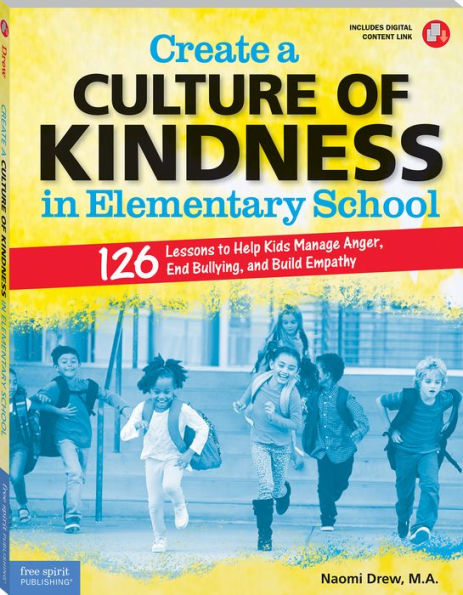Increase empathy in the elementary classroom with ready-to-use lessons that teach students positive skills and attitudes.
Kids learn better and feel better about themselves in an atmosphere of safety and respect. This book shows you how to help students in grades three through six:
With mini lessons that span those seven topic areas, you can build community and student relationships in 20 minutes or less per day. The prep work is already done: each of the 126 lessons has a script, and worksheets are available with the downloadable digital content.
Included in the book are anger management activities, conflict resolution strategies, and character-building lessons. And with concrete ideas about how to address bullying in the classroom, these lessons help students understand what bullying is and how they can stand up to bullies.
Based on a nationwide survey of more than 2,000 students and teachers, this resource can be used alone or as a complement to anti-bullying or character education programs already in place. The digital content in this book includes reproducible handouts, bonus activities, forms for parents, and information on schoolwide responses to bullying.
1136917562
Kids learn better and feel better about themselves in an atmosphere of safety and respect. This book shows you how to help students in grades three through six:
- Foster kindness, compassion, and empathy
- Manage anger
- Prevent conflict
- Respond to conflict
- Address name-calling and teasing
- Deal with bullying
- Accept differences
With mini lessons that span those seven topic areas, you can build community and student relationships in 20 minutes or less per day. The prep work is already done: each of the 126 lessons has a script, and worksheets are available with the downloadable digital content.
Included in the book are anger management activities, conflict resolution strategies, and character-building lessons. And with concrete ideas about how to address bullying in the classroom, these lessons help students understand what bullying is and how they can stand up to bullies.
Based on a nationwide survey of more than 2,000 students and teachers, this resource can be used alone or as a complement to anti-bullying or character education programs already in place. The digital content in this book includes reproducible handouts, bonus activities, forms for parents, and information on schoolwide responses to bullying.
Create a Culture of Kindness in Elementary School: 126 Lessons to Help Kids Manage Anger, End Bullying, and Build Empathy
Increase empathy in the elementary classroom with ready-to-use lessons that teach students positive skills and attitudes.
Kids learn better and feel better about themselves in an atmosphere of safety and respect. This book shows you how to help students in grades three through six:
With mini lessons that span those seven topic areas, you can build community and student relationships in 20 minutes or less per day. The prep work is already done: each of the 126 lessons has a script, and worksheets are available with the downloadable digital content.
Included in the book are anger management activities, conflict resolution strategies, and character-building lessons. And with concrete ideas about how to address bullying in the classroom, these lessons help students understand what bullying is and how they can stand up to bullies.
Based on a nationwide survey of more than 2,000 students and teachers, this resource can be used alone or as a complement to anti-bullying or character education programs already in place. The digital content in this book includes reproducible handouts, bonus activities, forms for parents, and information on schoolwide responses to bullying.
Kids learn better and feel better about themselves in an atmosphere of safety and respect. This book shows you how to help students in grades three through six:
- Foster kindness, compassion, and empathy
- Manage anger
- Prevent conflict
- Respond to conflict
- Address name-calling and teasing
- Deal with bullying
- Accept differences
With mini lessons that span those seven topic areas, you can build community and student relationships in 20 minutes or less per day. The prep work is already done: each of the 126 lessons has a script, and worksheets are available with the downloadable digital content.
Included in the book are anger management activities, conflict resolution strategies, and character-building lessons. And with concrete ideas about how to address bullying in the classroom, these lessons help students understand what bullying is and how they can stand up to bullies.
Based on a nationwide survey of more than 2,000 students and teachers, this resource can be used alone or as a complement to anti-bullying or character education programs already in place. The digital content in this book includes reproducible handouts, bonus activities, forms for parents, and information on schoolwide responses to bullying.
39.99
In Stock
5
1

Create a Culture of Kindness in Elementary School: 126 Lessons to Help Kids Manage Anger, End Bullying, and Build Empathy
304
Create a Culture of Kindness in Elementary School: 126 Lessons to Help Kids Manage Anger, End Bullying, and Build Empathy
304eBook (First Edition)
$39.99
Related collections and offers
39.99
In Stock

Product Details
| ISBN-13: | 9781631985959 |
|---|---|
| Publisher: | Free Spirit Publishing |
| Publication date: | 08/30/2021 |
| Series: | Free Spirit Professional® |
| Sold by: | Barnes & Noble |
| Format: | eBook |
| Pages: | 304 |
| File size: | 19 MB |
| Note: | This product may take a few minutes to download. |
| Age Range: | 8 - 11 Years |
About the Author
From the B&N Reads Blog
